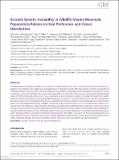Mostrar el registro sencillo del ítem
Brucella Genetic Variability in Wildlife Marine Mammals Populations Relates to Host Preference and Ocean Distribution
| dc.creator | Suárez Esquivel, Marcela | |
| dc.creator | Baker, Kate S. | |
| dc.creator | Ruiz Villalobos, Nazareth | |
| dc.creator | Hernández Mora, Gabriela | |
| dc.creator | Barquero Calvo, Elías | |
| dc.creator | Castillo Zeledón, Amanda | |
| dc.creator | Jiménez Rojas, César | |
| dc.creator | Chacón Díaz, Carlos | |
| dc.creator | Cloeckaert, Axel | |
| dc.creator | Chaves Olarte, Esteban | |
| dc.creator | Thomson, Nicholas R. | |
| dc.creator | Moreno Robles, Edgardo | |
| dc.creator | Guzmán Verri, Caterina | |
| dc.creator | González Barrientos, Rocío | |
| dc.date.accessioned | 2020-02-05T21:19:26Z | |
| dc.date.available | 2020-02-05T21:19:26Z | |
| dc.date.issued | 2017 | |
| dc.identifier.citation | https://academic.oup.com/gbe/article/9/7/1901/3980255 | |
| dc.identifier.issn | 1759-6653 | |
| dc.identifier.uri | https://hdl.handle.net/10669/80474 | |
| dc.description.abstract | Intracellular bacterial pathogens probably arose when their ancestor adapted from a free-living environment to an intracellular one, leading to clonal bacteria with smaller genomes and less sources of genetic plasticity. Still, this plasticity is needed to respond to the challenges posed by the host. Members of the Brucella genus are facultative-extracellular intracellular bacteria responsible for causing brucellosis in a variety of mammals. The various species keep different host preferences, virulence, and zoonotic potential despite having 97–99% similarity at genome level. Here, we describe elements of genetic variation in Brucella ceti isolated from wildlife dolphins inhabiting the Pacific Ocean and the Mediterranean Sea. Comparison with isolates obtained from marine mammals from the Atlantic Ocean and the broader Brucella genus showed distinctive traits according to oceanic distribution and preferred host. Marine mammal isolates display genetic variability, represented by an important number of IS711 elements as well as specific IS711 and SNPs genomic distribution clustering patterns. Extensive pseudogenization was found among isolates from marine mammals as compared with terrestrial ones, causing degradation in pathways related to energy, transport of metabolites, and regulation/ transcription. Brucella ceti isolates infecting particularly dolphin hosts, showed further degradation of metabolite transport pathways as well as pathways related to cell wall/membrane/envelope biogenesis and motility. Thus, gene loss through pseudogenization is a source of genetic variation in Brucella, whichinturn, relates to adaptation to different hosts.This is relevant to understand the natural history of bacterial diseases, their zoonotic potential, and the impact of human interventions such as domestication. | es_ES |
| dc.description.sponsorship | Comisión Nacional para la Gestión de la Biodiversidad/[R-028-203-OT]/CONAGEBIO/Costa Rica | es_ES |
| dc.description.sponsorship | Ministerio de Ciencia, Tecnología y Telecomunicaciones/[FV-004-13]/MICITT/Costa Rica | es_ES |
| dc.description.sponsorship | Wellcome Trust/[098051]/WT/Londres | es_ES |
| dc.description.sponsorship | Wellcome Trust/[106690/Z/14/Z]/WT/Londres | es_ES |
| dc.language.iso | en_US | es_ES |
| dc.relation.ispartof | ||
| dc.source | Genome Biology and Evolution, vol. 9(7), pp.1901–1912 | es_ES |
| dc.subject | Brucella | es_ES |
| dc.subject | Marine mammals | es_ES |
| dc.subject | Genome degradation | es_ES |
| dc.title | Brucella Genetic Variability in Wildlife Marine Mammals Populations Relates to Host Preference and Ocean Distribution | es_ES |
| dc.type | artículo original | |
| dc.date.updated | 2020-02-03T20:10:28Z | |
| dc.identifier.doi | 10.1093/gbe/evx137 | |
| dc.description.procedence | UCR::Vicerrectoría de Investigación::Unidades de Investigación::Ciencias de la Salud::Centro de Investigación en Enfermedades Tropicales (CIET) | es_ES |
Ficheros en el ítem
Este ítem aparece en la(s) siguiente(s) colección(ones)
-
Microbiología [1171]


